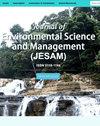Agrochemical Residues in Soil, Water, Chicken’sBlood and Worker’s Urine Samples in Rose Farms, Tak Province, Thailand
IF 0.3
4区 环境科学与生态学
Q4 ENVIRONMENTAL SCIENCES
引用次数: 0
Abstract
The agrochemical overuse, especially that of paraquat, cypermethrin and carbendazim, has been observed in Thailand. Residuals do not only contaminate the environment and agricultural products, but also other living organisms related to the farming. With less attention being paid to the agrochemical residues in the environment, this study aimed to quantify agrochemical residues in soil, water, chicken’s blood and worker’s urine samples across different periods of cultivation among nine rose farms in Tak Province, Thailand were selected as study sites. Various agrochemicals were used throughout the year; particular attention was paid to paraquat, cypermethrin and carbendazim. Soil and water samples represented the environment, chicken’s blood represented animal subjects, and urine samples of rose farmers represented human subjects. The study revealed the existence of those three agrochemical residues in both soil and water samples. It was only in soil samples that paraquat and cypermethrin concentrations were higher than the maximum allowable concentration (47.24 mg kg-1and 0.24 mg kg-1, respectively). Residues of cypermethrin and carbendazim were found only in chicken’s blood (0.0280 μg L-1 and 0.0750 - 0.1640 μg L-1, respectively). Since rose farmers were well equipped with personal protective equipment when applying the pesticides, paraquat, cypermethrin and carbendazim quantifications in their urine samples were all below the detectable limits of the instruments used. Further studies such as better methods for residue analysis and a larger sample size are needed. More reliable quantifications may possibly result in assessing the relationship between agrochemical residues among environmental and living organisms.泰国德省玫瑰农场土壤、水、鸡血液和工人尿液样本中的农药残留
泰国出现了农药过度使用的现象,特别是百草枯、氯氰菊酯和多菌灵。残留物不仅会污染环境和农产品,还会污染与农业相关的其他生物。由于对环境中农药残留的关注较少,本研究旨在量化泰国达克省9个玫瑰养殖场不同种植期土壤、水、鸡血和工人尿液中的农药残留。全年使用了各种农用化学品;特别注意百草枯、氯氰菊酯和多菌灵。土壤和水样本代表环境,鸡血代表动物受试者,玫瑰种植者的尿液样本代表人类受试者。这项研究揭示了这三种农药残留在土壤和水样中的存在。只有在土壤样品中,百草枯和氯氰菊酯的浓度高于最大允许浓度(分别为47.24 mg kg-1和0.24 mg kg-1)。氯氰菊酯和多菌灵的残留仅在鸡血中发现(分别为0.0280μg L-1和0.0750-0.1640μgL-1)。由于玫瑰种植者在施用杀虫剂时配备了良好的个人防护设备,他们尿液样本中的百草枯、氯氰菊酯和多菌灵的定量都低于所用仪器的检测限。需要进一步的研究,如更好的残留物分析方法和更大的样本量。更可靠的量化可能有助于评估环境生物和活体生物之间的农药残留之间的关系。
本文章由计算机程序翻译,如有差异,请以英文原文为准。
求助全文
约1分钟内获得全文
求助全文
来源期刊

Journal of Environmental Science and Management
ENVIRONMENTAL SCIENCES-
CiteScore
0.90
自引率
0.00%
发文量
10
审稿时长
2 months
期刊介绍:
The Journal of Environmental Science and Management (JESAM) is an international scientific journal produced semi-annually by the University of the Philippines Los Baños (UPLB).
JESAM gives particular premium to manuscript submissions that employ integrated methods resulting to analyses that provide new insights in environmental science, particularly in the areas of:
environmental planning and management;
protected areas development, planning, and management;
community-based resources management;
environmental chemistry and toxicology;
environmental restoration;
social theory and environment; and
environmental security and management.
 求助内容:
求助内容: 应助结果提醒方式:
应助结果提醒方式:


